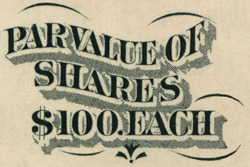Glossary of stock certificate terms
Assessable stock. Typical type of stock sold prior to the mid-1800s; companies could assess funds from stockholders for more than stated par values.
Bearer stock. Stock controlled by whomever held the certificate. Rare among North American certificates.
Capital statement. A value, stated in units of currency, normally indicating a company's theoretical capitalization at the time of issuance. It is the sum of all authorized shares times par value. (i.e. 5,000 shares authorized at $100 per share par value equals a capitalization of $50,000.)
Capital stock. The entire issuance of all types of stock including common and preferred. Usually synonymous with common stock when only one class of stock was issued.

Classes of stock. Different types of stock issued by companies, each with different voting and dividend rights. Common and preferred are the two most familiar sub-classes of stock. Some companies sub-divided stock into "Class A," "Class B," and so forth. Some classes were not entitled to dividends or voting rights. Some was salable only back to issuing companies.
Common stock. Typical stock. When companies pay dividends, stockholders share in profits in proportion to the number of shares they own. Many modern companies do not pay dividends, so profit depends on growth in share prices.

Convertible preferred stock. Preferred stock with special provisions that allow conversion to common stock at designated times and prices.
Corporate stock. The entire issuance of common and preferred stock. Synonymous with common stock or capital stock among companies that issue a single class of stock.
Cumulative preferred stock. Preferred stock that allows companies to postpone dividend payments, thereby allowing dividends to accumulate.
Dividends. Portions of company profits, equally divided on a per-share basis.
Fully paid and non-assessable. Stock that prevents companies from assessing shareholders for more funds.
No-par stocks. Stock with no stated share value. Companies sell no par stock at whatever amounts investors are willing to pay.

Non-assessable stock. Stock immune from future company demands for investment. The vast majority of stocks sold on North American exchanges ceased being assessable around 1900 to 1910, but many late-date stock certificates still displayed the "Fully paid and non-assessable" notice.
Non-voting stock. A type of stock that offers dividends to stockholders, but does not allow them to vote on issues related to corporate management.
Odd lot. Financial jargon for stock sold in amounts of less than 100 shares.
 Par value. Par value initially meant the selling price of a single share of stock. More specifically, it meant the price companies charged investors to buy their stock. Once stock was in the hands of investors, shares sold at whatever prices the market would bear. The term later evolved into a bookkeeping term. Confusion eventually forced companies to state that their stocks had 1-cent par values or "no-par value".
Par value. Par value initially meant the selling price of a single share of stock. More specifically, it meant the price companies charged investors to buy their stock. Once stock was in the hands of investors, shares sold at whatever prices the market would bear. The term later evolved into a bookkeeping term. Confusion eventually forced companies to state that their stocks had 1-cent par values or "no-par value".
Participating preferred stock. Preferred stock with special provisions that allow stockholders to receive extra dividends if the company shows excess profits.
Penny stocks. Financial jargon for shares that trade for fractions of a dollar or shares with stated par values under a dollar.
Preferred stock. Stock given preference when disbursing normal dividends. Because of preferential status, preferred stocks receive dividends even when there is insufficient profit to pay dividends on common stocks. Preferred stocks also receive preferential treatment if there are any assets left after a company dissolves. Dividends on preferred stock are normally fixed and do not vary like those for common stocks. Unless specifically addressed in corporate by-laws, preferred stock does not benefit when corporate profits are higher than expected. Preferred stock may or may not confer voting rights.
Pre-printed share value. A value of a stock certificate meant to indicate a fixed number of shares being issued.

 Punch panel. Term used in this project (and known elsewhere by different names) to describe a panel in the borders of stock certificates meant to be punched to indicate the numbers of shares being issued. Punch panels normally consist of two columns of ten numbers that allowed issuance of 1 to 99 shares. A few certificates show punch panels with as many as five column of numbers which allowed issuance of as many as 99,999 shares.
Punch panel. Term used in this project (and known elsewhere by different names) to describe a panel in the borders of stock certificates meant to be punched to indicate the numbers of shares being issued. Punch panels normally consist of two columns of ten numbers that allowed issuance of 1 to 99 shares. A few certificates show punch panels with as many as five column of numbers which allowed issuance of as many as 99,999 shares.
Reverse stock split. A decrease in the number of company shares meant to increase the market price of shares that have fallen below acceptable levels. Also known as a stock consolidation.
Round lot. Financial jargon for shares sold in increments of 100 shares.
Serial number frame. A (generally) ornamental frame meant to hold the handwritten, typed, stamped, or printed serial number. Serial numbers frames typically appear in the top left quadrant of stock certificates.

Share. Equal portion of ownership rights and interest in a company. Shares are issued only by companies that have been officially organized under the laws of states, provinces, or Federal governments. The term is also used to indicate ownership in equipment trusts even though trusts are usual issued in $1,000 amounts.
Share value frame. A frame, generally ornamental, meant to hold a number indicating the numbers of shares issued. Share values typically appear in the upper right quadrant of most stock certificates.

Stock split. A division of a company's shares into multiples. A "2 for 1" split doubles the number of shares available to investors. Collectors can often identify "2 for 1" stock splits when they notice $100 shares changed at later dates to $50 par values. Railroad companies often split stock when share prices exceeded $100 for extended periods or when there was great demand for company stock.
Trust certificate. A certificate produced by a trust company or trustees meant to be traded for genuine company-issued certificates in order to hold voting rights. These were normally issued during periods of financial stress or reorganization in order to concentrate voting power on behalf of shareholder interests.
